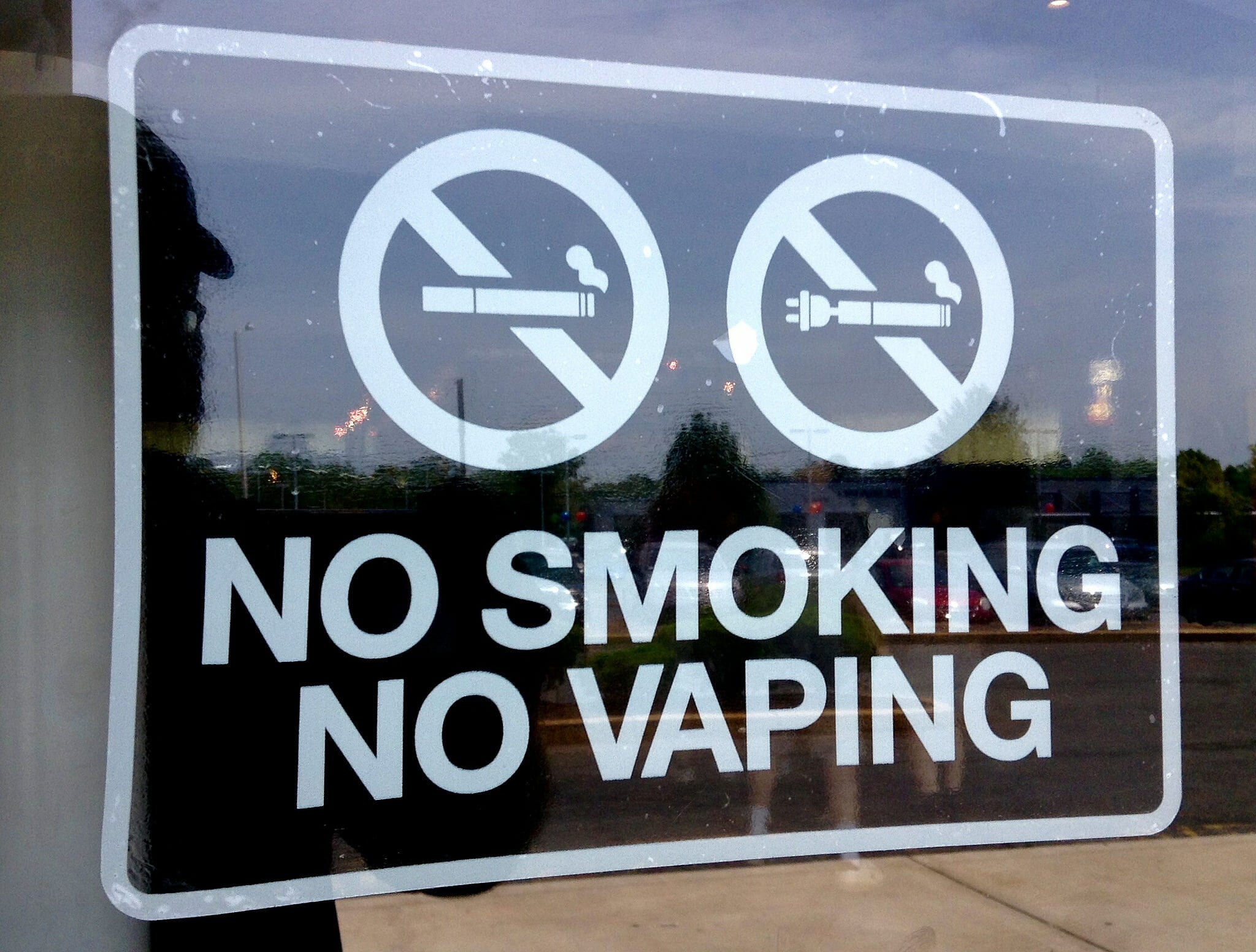When e-cigarettes hit the market they seemed like a godsend to smokers (and maybe even curious nonsmokers): all the enjoyment of smoking cigarettes and none, or at least far fewer, of the health risks. You’re only breathing in water vapor and pure nicotine, the ads said. Is vaping bad for you?
Have those claims held up since e-cigarettes were introduced to the U.S. and European markets 10 years ago? The science is a bit more complicated than it seems, with scientists doggedly fighting to heavily regulate e-cigarettes, and others touting them as the ultimate smoking cessation device. Here’s what you should know about why vaping is bad for you, how e-cigs work, and what you should do to change your habits.
Is vaping bad for you?
So is vaping really that bad for you? Most experts agree that the risk of cancer is likely lower in vaping than traditional cigarettes—but the effects from the ultrafine particles involved are comparable, and the science behind e-cigarettes is still young and relatively inconclusive.
The Food and Drug Administration only began regulating e-cigarettes in August 2016, which essentially allowed e-cigarette manufacturers to operate without much oversight on nicotine contents and other chemical components in their e-cigarette liquids.
READ MORE:
- A beginner’s guide to vaping
- How much does a gram of weed cost
- Important website lets you vote on which celebrity you think is more likely to vape
- Is weed actually bad for you?
Cancers, lung disease, and heart disease all take several years to develop—people haven’t been using e-cigarettes long enough to develop these diseases. Also, most e-cigarette users (called “vapers”) are current or former smokers, so it will be hard to parse out whether smoking or vaping was the true culprit of whatever diseases do form. Besides, for many vapers who turning to e-cigarettes to stave off cigarette addition, there’s the question of whether or not vaping is considered “straight-edge” or an addiction of its own. (Noisey‘s rudimentary investigation into this question provides a quick and entertaining glimpse into the vape world for those on the outside.)
Researchers can study the effects of e-cigarette aerosol in cultured cells and lab animals, but those studies can’t definitively tell us what real-world e-cigarette use will look like in the long term. Lastly, several researchers are attempting to answer the question of whether or not e-cigarettes can be used to effectively quit smoking. But that question has a complicated, incomplete answer too. Let’s break it down, starting with the physical differences between traditional and e-cigarettes.

Combustion vs. vaporization
Much of what makes traditional cigarettes so dangerous isn’t the nicotine. Nicotine is super addictive and can cause heart disease, but there’s very little evidence that it causes cancer. Cigarettes are dangerous because of the smoke itself. Lighting up causes the tobacco leaves and cellulose paper they’re wrapped in to combust. And combustion of plant matter releases several other chemicals: aldehydes, carbon monoxide, free radicals, heavy metals—a combination that can cause not only cancer but lead to heart and lung diseases as well.
E-cigarettes, on the other hand, use a battery to vaporize a mixture of nicotine, glycerol or propylene glycol, and flavorings, depending on the product. Vaporization happens at a much lower temperature than combustion, so it seems reasonable that it wouldn’t cause the release of all the same nasties as cigarettes.
“The cancer risk is probably lower than a conventional cigarette, but the effects of the ultrafine particles and the aldehydes are about the same.”
But you’re not just breathing in nicotine and water vapor, according to Stanton Glantz, professor of medicine and director of the Center for Tobacco Control Research and Education at the University of California, San Francisco.
“In the process of heating up [e-cigarette liquid,] you get a lot of aldehydes and the ultrafine particles are themselves dangerous,” Glantz told the Daily Dot over the phone. “The cancer risk is probably lower than a conventional cigarette, but the effects of the ultrafine particles and the aldehydes are about the same.”
Vaping side effects
The effects of the particulates may include inflammation in the lungs that can cause lung disease over time. One study found that cultured white blood cells exposed to e-cigarette vapor extract released inflammation-causing compounds, suggesting that breathing e-cigarette vapor may have similar effects on the body. Glantz also said that the particulates in both e-cigarette vapor, cigarette smoke, and air pollution can also cause the blood to get “sticky,” leading to clogged arteries and heart disease.
The preliminary evidence agrees with Glantz’s views. According to two reviews, e-cigarette vapor is quite harmful in animal and cell culture studies. However, detractors from e-cigarettes tend to argue that e-cigarettes also release aldehydes—but there’s reason to be skeptical, according to the second review. One study found that e-cigarette vapor contained formaldehyde—the same probable-cancer-causing chemical used to preserve animals for dissection. However, some argued that the temperature used to create the e-cigarette vapor in that study was too high. Vaping at too-high temperatures causes a phenomenon called a “dry puff,” which is very harsh and unpleasant, as anyone who’s ever tried an e-cigarette can tell you.

According to a 2015 study in the journal Addiction, e-cigarettes only release formaldehyde in the “dry puff” condition.
Another study conducted by researchers at the University of Connecticut used an “artificial inhalation technique” to simulate the health effects of e-cig smoking. It found that nicotine e-cigarettes and unfiltered cigarettes are equivalent to “quite significant levels of potent tobacco carcinogen” and are likely to cause DNA damage. One of the researchers said he was “shocked” by the results and concluded after several more tests that compounds found in e-cigs, most likely chemical additives, were “definitely causing damage to DNA.”
The UConn study was met with harsh criticism from those who believe the university was using it to make money off its new testing technique. Carl Alexander of Cancer Research U.K. told the Daily Dot he was more skeptical of the lab study’s real-world significance. “The test needs to be developed further and validated before it can be used to draw any conclusions about the effects of e-cigarettes,” he said.

E-cigarettes are a moving target
Over the course of more than 10 years on the market, e-cigarette devices have changed rapidly. The first generation e-cigarettes looked a lot like traditional ones (they’re also known as “cigalikes”), but weren’t as good at getting nicotine into the blood as traditional cigarettes.
“Time will tell whether or not that chronic inflammation will lead to disease.”
But the newer generation e-cigarettes deliver nicotine to the bloodstream at levels comparable to regular cigarettes, meaning they can give vapers the same nicotine fix as smokers. This is good news for their potential to help smokers quit smoking. But there’s a catch.
“Most of the data I’ve seen on second and third-generation devices is that they do cause inflammation in the lungs. They do cause a measurable biological response,” Robert Teran, lead author of the second review and director of SoM Tobacco Center of Regulatory Science at the University of North Carolina, Chapel Hill said in a phone interview with the Daily Dot. “Time will tell whether or not that chronic inflammation will lead to disease.”
Additionally, e-cigarettes introduce a few variables that traditional cigarettes do not. Flavorings are common in e-cigarette liquids. While the chemicals used to create those flavors are all on the FDA’s approved list of food additives, pretty much no one has studied the effect of inhaling the vapors of these chemicals, Teran said.
There is one notable exception: diacetyl. Diacetyl is the primary chemical that gives movie theater popcorn its buttery flavor. It’s also a byproduct in many other foods: it gives some Chardonnays their signature buttery undertones. If you pick it up in beer, that can also be a sign that your local bar needs to clean the lines in their beer taps.
“It’s safe to eat, but if you breathe it in it causes bronchiolitis obliterans,” otherwise known as popcorn lung, Teran said. And the only reason researchers know about the harmful effects of breathing in diacetyl is because workers in popcorn factories came down with this illness.
But diacetyl isn’t just in buttery flavors. It’s also in a lot of berry flavorings as well, according to one study found diacetyl in 39 of 51 e-cigarette flavors. However, diacetyl is also present in cigarette smoke—at levels higher than those experienced by workers in popcorn factories, according to a 2014 study. So maybe it’s a wash with diacetyl.
Nonetheless, there are still many compounds in e-cigarette flavorings whose effects on the lungs are still relatively unknown. In fact, Teran believes that e-cigarettes and traditional cigarettes might have more differences than similarities, and comparing them to one another might not be the best way to assess e-cigarette’s health risks. After all, being “safer than smoking” is a very low bar to clear.
Teran cited a study from his lab that found vaping was associated with suppression of genes related to the immune system. The researchers even found many suppressed genes in vapers that they didn’t find in smokers, suggesting vaping may have some unique effects on the immune system.

A 2018 study conducted by the University of California, San Francisco’s Division of Adolescent Medicine appears to confirm some of those findings. It discovered higher levels of carcinogens in urine samples of teenagers who inhale e-cigarettes than those who don’t. Interestingly, fruity e-cigs have more acrylonitrile—a toxic substance in plastics—than menthol, candy, and tobacco flavors.
“Messaging to teenagers should include warnings about the potential risk from toxic exposure to carcinogenic compounds generated by these products,” the study concluded.
The experiment looked at the urine and saliva of 67 e-cig smokers and compared it to 16 who both vape and smoke and 20 who do neither. It confirmed inhaling both e-cigs and combustible cigarettes result in higher amounts of cancer-causing materials than vaping alone.
The ultimate cessation aid?
To say quitting smoking is hard is an understatement. Nicotine isn’t just highly addictive; it can literally change the development of the brain to make people even more dependent on it if they start smoking in their teens—which is exactly when most smokers start. Smokers looking to quit have a few options: cold turkey, gradually cutting back, using a nicotine replacement therapy, or a drug like Chantix.
Nicotine replacement therapy—using something like the patch or gum—helps smokers get their nicotine fix and taper them off of nicotine while keeping them from smoking. Many people may choose to go these treatments alone by buying the therapies over the counter at the drugstore.
According to a study from the ’90s, quit rates for people who do the patch or gum alone, without the help of their doctor, vary between around 15 percent after six weeks, to less than 10 percent at 24 weeks follow-up. But subsequent reviews of that study and others like it that attempted to gain “real world” evidence for replacement therapies found their methodologies to be flawed.
Another review of nicotine replacement therapies found that people may be more successful if they had behavioral support such as a hotline to call or group therapy sessions. But quit rates are still low. Replacement therapy only enhances someone’s chances of quitting by 50 to 70 percent, according to the review. So if someone goes cold turkey without any support and has an 8 percent chance of success, using replacement therapy is only going to make their chances marginally greater—and that’s only to smokers who are very highly motivated to quit.
One study published in July 2018 showed that of the 30 percent of respondents who both smoked cigarettes and vaped, almost all were still smoking cigarettes after a year. A Georgia State epidemiologist speculated to Gizmodo that “the way smokers can use e-cigarettes to complement their nicotine uptake and alleviate withdrawal symptoms in situations when they cannot smoke” could actually make matters worse instead of better.
READ MORE:
- How to make weed butter without wasting your entire Saturday
- Here are 6 Amazon products that are definitely not for cocaine
- 12 legal drugs that will give you a psychedelic trip
- How to buy drugs on the deep web
It’s unclear why quit rates are so low with replacement therapy. But part of the issue may be that smoking is more than just nicotine: it’s the ritual and social aspects too. E-cigarettes provide many of those same comforts, so some researchers believe they can be highly effective quitting tools.
“I think someone specifically comes and seeks treatment, then I would recommend Chantix or nicotine replacement treatment, possibly supplemented by e-cigarettes,” Peter Hajek, director of Tobacco Dependence Research Unit at the Wolfson Institute of Preventive Medicine in London, told the Daily Dot in a phone interview. “So many smokers only manage to stop smoking when they try a few of these e-cigarette models.”
Hajek was involved in a 2014 review of e-cigarettes for smoking cessation. He and his colleagues found that e-cigarettes containing nicotine were more helpful than e-cigarettes without, but they couldn’t determine if they were any better than the patch. Nonetheless, Hajek and colleagues in the Royal College of Physicians now urge smokers to make the switch to e-cigarettes, citing that they are 95 percent less harmful than cigarettes.
“They got six people together, several of whom had financial conflicts of interest, got around a table and scratched their head and scratched their butt and got that 95 percent number.”
How they got to that number is unclear. When the Daily Dot asked Hajek about it directly, he cited the many known toxic chemicals in cigarette smoke that lead to heart disease, lung disease, and cancer.
“These chemicals are either totally absent or present in only minuscule amounts in e-cigarette vapor,” Hajek said “Chemicals exclusive to vaping may yet be found to also pose some risks, but this is unlikely to be more than only a small fraction of the risks of smoking.”
But 95 percent less harmful seems like a long shot to Glantz.
“The 95 percent number … was simply made up,” he said. “If you go back and find the paper that comes up with that number. It has exactly no actual evidence in it. They got six people together, several of whom had financial conflicts of interest, got around a table and scratched their head and scratched their butt and got that 95 percent number.”
Board members at the National Academies of Sciences, Engineering, and, Medicine concluded in a comprehensive January 2018 report that, while e-cigarettes may help adults quit smoking, there’s “substantial evidence” of it being a gateway for youths to start smoking conventional cigarettes. It, therefore, can increase the likelihood of teens exposing themselves to cancer-causing toxins.
Are e-cigs less dangerous?
Glantz thinks, if anything, e-cigarettes are about “a third to a half” as dangerous. Much of Glantz’s work has also been to disprove the idea that e-cigarettes are useful smoking cessation tools when used alone. Earlier this year, he and his colleague published an analysis of several studies in the Lancet that e-cigarette users were 28 percent less likely to quit smoking than those who didn’t use e-cigarettes.
“The most dangerous thing about e-cigarettes is that they keep people smoking. If you were a cigarette smoker and you switched entirely from cigarettes to e-cigarettes, it would be less dangerous,” Glantz said. “The majority of the data suggests most people are dual users.”
He added that he believes e-cigarettes have definitely helped some people quit. But he thinks that they would only work for a minority of smokers.
The congressionally mandated report from the National Academies of Sciences, Engineering, and Medicine, which is based on 800 scientific studies, found e-cigarettes contain and emit harmful toxic substances, citing “conclusive evidence.”
However, the same report said substituting combustible cigarettes with e-cigs lowers users’ exposure to toxicants and carcinogens and reduces short-term adverse effects on several organs. The research found no conclusive evidence whether or not long-term effects of vaping could increase the risk of cancer.
“Under the assumption that e-cigarette use increases the rate at which adults quit conventional smoking, modeling projects that use of e-cigarettes will generate a net public health benefit, at least in the short run,” the report reads.

Research conducted by the University of California San Diego (UCSD), however, shows e-cigarette smoking may be a better cessation tool than many thought. A study published in July 2017 looked at data spanning almost 15 years and concluded smokers who use e-cigarettes are more likely to quit their nicotine habit than those who don’t.
The study determined e-cigarette users are 25 percent more likely than non-users to attempt to quit smoking, and 3.4 percent more likely to succeed. It found a 1.1 percent increase (about 350,000 smokers) in the overall U.S. population smoking cessation rate from 2010-2011 to 2014-15.
The study did have some limitations. Because they looked at survey data, researchers had a limited set of information to work with and couldn’t confirm details like which e-cigarettes were used or if users were also taking medication to quit.
Shu-Hong Zhu, a professor at the Department of Medicine and Family Health at UCSD and author of the study, told the Daily Dot that other factors like the TIPS from Former Smokers ad campaign in 2012 or tobacco tax in 2009 may have influenced the cessation rate.
Nevertheless, UCSD researchers recommended their results be “weighed carefully” in regulatory policy. A few days later, the FDA extended the deadline for regulation on e-cigarettes to 2022.

So, is vaping bad for you long-term?
There’s reason to believe that e-cigarette use may be less damaging long-term than traditional smoking. A study funded by Cancer Research UK and published in February 2017 looked at five groups: combustible cigarette users, former smokers who now smoke e-cigs, former smokers on nicotine replacement therapy (NRT), and current smokers who also smoke e-cigs or also use NRT. The study e-cigarette-only and NRT-only users had significantly lower levels of measured carcinogens and toxins compared than traditional smokers.
“The take-home message for smokers and e-cigarette users is that using e-cigarettes long-term is likely to carry substantial health benefits, certainly in relation to cancer risk, compared with continued smoking. E-cigarettes are certainly safer than combustible cigarettes,” Lion Shahab, one of the scientists working on the study, told Digital Trends.
Sponsored by the U.S. Food and Drug Administration (FDA), the National Academies of Sciences, Engineering, and Medicine’s report says the long-term effects of vaping are uncertain, but its potential to lure teens into smoking combustible cigarettes could cause serious damage.
“The harms caused by the higher rate of conventional cigarette smoking among youth who had used e-cigarettes will take decades to appear. For long-range projections, the net public health benefit is substantially less, and under some scenarios the net impact is harmful.”
Editor’s note: This article is regularly updated for relevance.
